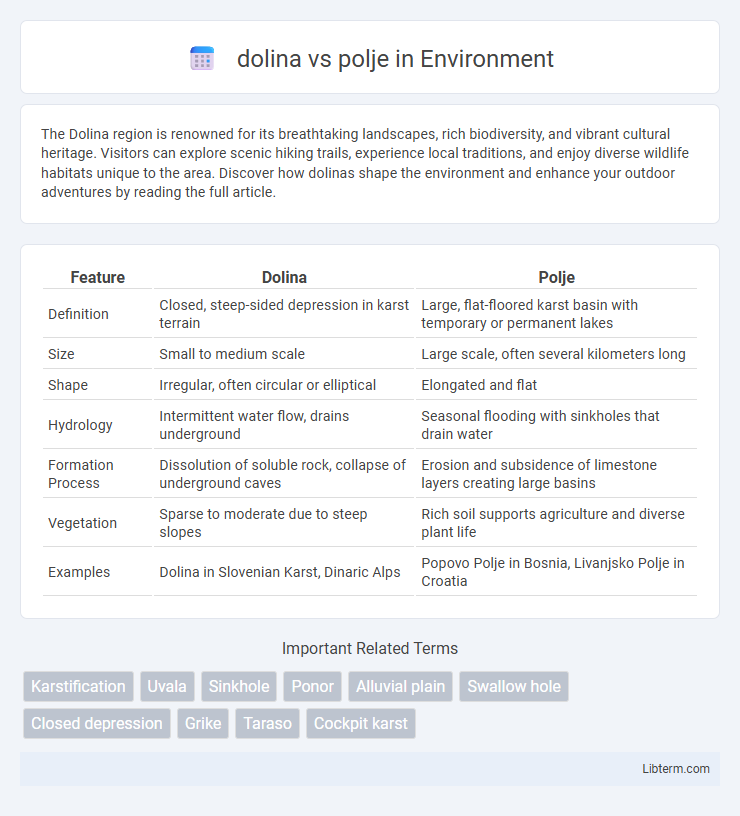The Dolina region is renowned for its breathtaking landscapes, rich biodiversity, and vibrant cultural heritage. Visitors can explore scenic hiking trails, experience local traditions, and enjoy diverse wildlife habitats unique to the area. Discover how dolinas shape the environment and enhance your outdoor adventures by reading the full article.
Table of Comparison
| Feature | Dolina | Polje |
|---|---|---|
| Definition | Closed, steep-sided depression in karst terrain | Large, flat-floored karst basin with temporary or permanent lakes |
| Size | Small to medium scale | Large scale, often several kilometers long |
| Shape | Irregular, often circular or elliptical | Elongated and flat |
| Hydrology | Intermittent water flow, drains underground | Seasonal flooding with sinkholes that drain water |
| Formation Process | Dissolution of soluble rock, collapse of underground caves | Erosion and subsidence of limestone layers creating large basins |
| Vegetation | Sparse to moderate due to steep slopes | Rich soil supports agriculture and diverse plant life |
| Examples | Dolina in Slovenian Karst, Dinaric Alps | Popovo Polje in Bosnia, Livanjsko Polje in Croatia |
Introduction to Dolina and Polje
Dolina and polje are karst landforms formed by the dissolution of soluble rocks such as limestone. Dolinas are small, circular depressions typically measuring from a few meters to several hundred meters in diameter, often formed by surface water erosion or collapse of underground cavities. Poljes are large, flat-floored basins spanning several kilometers, characterized by periodic flooding and sediment accumulation, serving as important agricultural areas in karst regions.
Definition of Dolina
A dolina is a type of karst depression formed by the dissolution of soluble rocks such as limestone, typically characterized by steep sides and a closed basin structure. It contrasts with a polje, which is a larger, flat-floored karst basin often featuring periodic flooding and more extensive sediment accumulation. Dolinas are important geomorphological features that indicate active chemical weathering and groundwater processes in karst landscapes.
Definition of Polje
A polje is a large, flat-floored depression in karst landscapes, characterized by its extensive size and enclosed drainage basin. Unlike a dolina, which is typically a small sinkhole formed by the dissolution of soluble rocks, a polje often spans several kilometers and supports seasonal or permanent agricultural use due to its fertile soil. These geomorphological features result from complex underground water erosion and collapse, leading to distinctive topographies in regions like the Dinaric Alps.
Formation Processes: Dolina vs Polje
Dolina and polje are karst landforms formed by the dissolution of soluble rocks such as limestone, but their formation processes differ significantly. Dolinas are typically smaller depressions created by localized surface or subsurface dissolution and the collapse of underground voids, whereas poljes are larger, flat-floored karst basins formed through extensive subsidence and the integration of multiple dolinas, often influenced by tectonic activity. The scale and complexity of polje formation involve prolonged chemical weathering, structural faulting, and sediment infill, distinguishing them from the more isolated and simpler dolina depressions.
Geological Features Comparison
Dolina and polje are karst landforms distinguished by their geological features; dolinas are small, circular depressions formed by the collapse of limestone bedrock or solution processes, typically measuring a few meters to hundreds of meters in diameter. In contrast, poljes are extensive, flat-floored depressions often spanning several kilometers, characterized by alluvial sediments and periodic flooding due to their closed drainage systems within limestone terrains. Both features illustrate karst processes but differ significantly in scale, morphology, and hydrological behavior.
Hydrology: Water Systems in Dolina and Polje
Dolina features closed depression water systems where surface water is typically funneled into subterranean channels, influencing localized groundwater recharge and karst aquifer dynamics. Polje, as expansive flat-floored karst basins, exhibits complex hydrology with intermittent lakes and sinking streams that create variable surface water storage and periodic flooding, playing a crucial role in regional flood regulation and aquifer discharge. Both doline and polje environments critically impact speleogenesis and underground water flow patterns within karst landscapes.
Ecological Significance of Each Landform
Dolina and polje landscapes play crucial roles in karst ecosystems by supporting unique habitats and biodiversity adapted to soluble rock environments. Dolinas, or sinkholes, facilitate groundwater recharge and provide microhabitats for specialized flora and fauna, contributing to ecological connectivity. Poljes, large karstic plains, serve as seasonal wetlands and agricultural zones, sustaining diverse species and acting as vital water retention areas for flood regulation and nutrient cycling.
Global Distribution and Notable Examples
Dolines primarily occur in karst regions worldwide, with significant concentrations in the Dinaric Alps of Southeast Europe, including Slovenia and Croatia, as well as the Kentucky Karst in the United States. Poljes, characterized by their large, flat-floored depressions, are prominently distributed across the Balkans, particularly in Bosnia and Herzegovina, and also appear in southern China and parts of the Mediterranean basin. Notable examples of dolines include the Skocjan Caves dolines in Slovenia and the Sinking Spring dolines in Kentucky, while classic poljes are exemplified by the Livanjsko Polje in Bosnia and the Sinan Polje in China.
Uses and Human Impact
Dolinas serve as natural depressions often used for water collection and traditional agriculture, fostering localized farming communities. Poljes, expansive karst plains with fertile soil, support extensive crop cultivation and livestock grazing, enabling significant settlements and economic activities. Human impact on these features includes land modification for agriculture, water management challenges, and potential ecological disturbances from intensified land use.
Key Differences Between Dolina and Polje
Dolina are smaller, typically depression-like landforms formed by sinkhole processes in karst landscapes, while polje are large, flat-floored basins with fertile soils and often seasonal lakes or rivers. Dolina primarily result from dissolution and collapse of limestone, whereas polje involve groundwater drainage networks and can cover extensive areas up to several kilometers. Polje serve as agricultural hubs due to their size and soil quality, contrasting with the more localized, sink-like structure of dolina.
dolina Infographic

 libterm.com
libterm.com